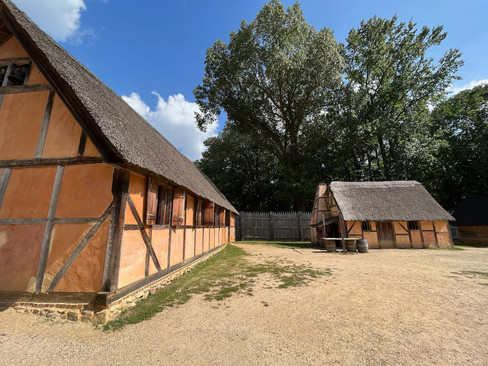- uniquejt
A Week in the Williamsburg Triangle
After getting past the drama of Thursday we used the weekend to re-set. Sunday morning we attended the Newport News Calvary Chapel for church services. The music and message was just the right medicine to get me back into the right place with the proper perspective I needed.

Our campsite in the Cheatham Annex is right in the middle of this historic region. The Williamsburg Triangle (also known to some as the Historic Triangle) encompasses three sites of huge historical significance. Located on the Virginia Peninsula, the triangle is enclosed by the famous York and James Rivers on either side and features Jamestown, Yorktown and Colonial Williamsburg at its points.
The National Park Service's Colonial Parkway was constructed to connect the three historic attractions of Colonial Virginia with a scenic and bucolic roadway carefully shielded from views of commercial development. Intended to help visitors mentally return to the past, it has views of waterway and natural areas, wildlife and waterfowl along the roadway (and crossing it). The only human development that can be seen from most of the parkway is the two loading piers of Cheatham Annex, part of the Naval Weapons Station Yorktown, which borders the inland side of much of the parkway.
Near the ends of the parkway at the James River and York River, there are several pull-offs where visitors can admire the view. The Colonial Parkway is free of tolls or user fees.
The Parkway starts in Yorktown, passes through Colonial Williamsburg and ends in Jamestown. No commercial vehicles are allowed to use the parkway for transportation, although commuter traffic has increased dramatically in the early 21st century.

The first permanent English settlement in the New World was established at Jamestown on May 13, 1607. There are two major heritage sites at Jamestown: (1) Jamestown Settlement, a living history museum which includes a reconstructed Native American village, colonial fort, and replica ships operated by the Commonwealth of Virginia; and (2) Historic Jamestowne, the National Park Service site which includes Jamestown Island and the ongoing archaeological projects.

In 1699, the capital of Virginia was moved from Jamestown to a location on high ground at Middle Plantation at the suggestion of students from the College of William and Mary, which had been established there in 1693. Middle Plantation was soon renamed Williamsburg, in honor of King William III, and it was a busy place until the American Revolution.
In 1780 during the revolution, the capital and government were moved to a more secure location at Richmond. Williamsburg became a largely sleepy little town for almost 150 years, as many young people left the Tidewater area in search of new lands to the west and other frontiers. In the early 20th century, the town was revived due to the preservation efforts of Reverend Dr. W.A.R. Goodwin, rector of Bruton Parish Church, and the generosity of Standard Oil heir John D. Rockefeller Jr. and his family, who shared a dream of restoring the old colonial capital city to its 18th-century state. They worked for decades to develop that vision to honor the later colonial capital.

Today, as the result of those efforts, Colonial Williamsburg is a large living museum of early American life. It has 88 original buildings and dozens of restored and recreated buildings as well as re-enactors. It is one of the most popular tourist destinations in the world. The Visitor's Center (right off the Colonial Parkway) features a short movie. It has a parking area, as automobiles are restricted from the restored area. A wheelchair-accessible shuttle bus service is provided.

The third point of the triangle is Yorktown, where General Cornwallis surrendered to George Washington in 1781 after the last land battle of the American Revolution. There are two large visitor centers, battlefield drives, and a waterfront area. The downtown historic area has numerous buildings from the pre-Revolutionary era.

We spent the better part of our time at Jamestown and Yorktown. Williamsburg really requires multiple days to experience properly due to its size. We will certainly be back to visit again. Wednesday, October 4 we had brunch with our friends, John and Ellen Clements, who drove up from Virginia Beach. The rest of our afternoon was spent washing the RV, the truck and getting ready to depart on Thursday.



























